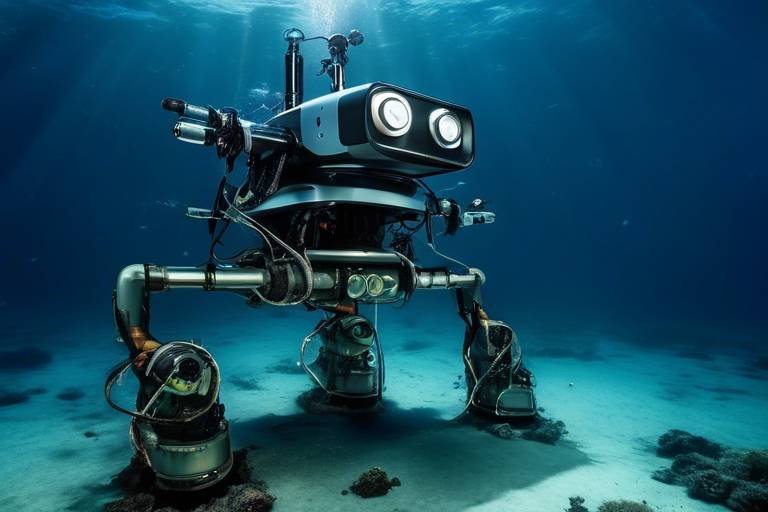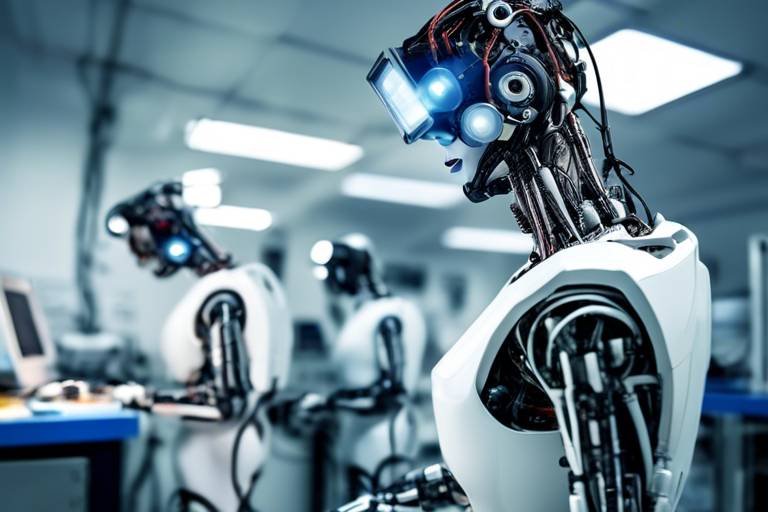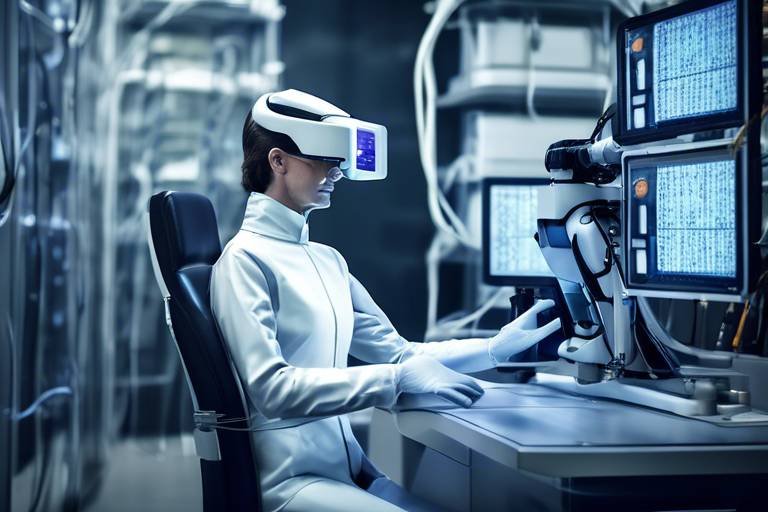The Future of Robotics in Underwater Exploration
Have you ever gazed into the deep blue ocean and wondered what secrets lie beneath its waves? The future of robotics in underwater exploration is not just a fantasy; it's becoming a reality that promises to unveil the mysteries of the marine world. As technology leaps forward, we are witnessing an incredible transformation in how we explore and understand our oceans. Robotics is at the forefront of this evolution, paving the way for groundbreaking discoveries and enhanced environmental stewardship.
Imagine a world where underwater robots can dive deeper, stay longer, and gather more data than ever before. This isn’t just wishful thinking; it’s happening right now! Recent advancements have led to the development of autonomous underwater vehicles (AUVs) and remotely operated vehicles (ROVs) that can withstand extreme pressures, navigate treacherous terrains, and operate in total darkness. These robotic explorers are equipped with sophisticated sensors and imaging technologies that allow them to capture high-resolution images and collect vital environmental data.
But why does this matter? Well, the ocean covers over 70% of our planet, yet we have only explored a fraction of it. With underwater robotics, researchers can access previously unreachable areas, from deep-sea trenches to the icy polar regions. This capability not only enhances our understanding of marine ecosystems but also aids in the conservation of endangered species and habitats. The implications are enormous, as we work to understand the impact of climate change and human activity on these delicate environments.
As we look toward the future, the integration of artificial intelligence (AI) and machine learning into underwater robotics is set to revolutionize exploration. These technologies will allow robots to make real-time decisions, adapt to changing environments, and even collaborate with human researchers in unprecedented ways. Imagine a fleet of underwater drones working together, sharing data instantaneously, and mapping the ocean floor with incredible precision. The potential for discovery is limitless!
However, it's essential to recognize that with great advancements come significant challenges. While the technology is improving, underwater robotics still faces hurdles such as technical limitations, high operational costs, and the need for better communication systems in the deep sea. But with ongoing research and investment in this field, we are optimistic that these challenges will be overcome, paving the way for a new era of underwater exploration.
In conclusion, the future of robotics in underwater exploration is bright and full of promise. As we continue to push the boundaries of technology, we are not only enhancing our understanding of the ocean but also taking crucial steps towards protecting it. The mysteries of the deep are calling, and with the help of advanced robotics, we are more equipped than ever to answer that call.
- What are underwater robots used for? Underwater robots are utilized for various applications including scientific research, environmental monitoring, search and rescue operations, and underwater construction.
- How do underwater robots collect data? They are equipped with advanced sensors and imaging technologies that allow them to gather high-resolution images and real-time environmental data.
- What challenges do underwater robots face? Key challenges include technical limitations such as battery life and maneuverability, high operational costs, and the need for improved communication systems in deep-sea environments.
- What is the future of underwater robotics? The future looks promising with advancements in AI and machine learning, which will enable robots to operate more autonomously and collaborate effectively with human researchers.

Advancements in Underwater Robotics
Recent technological breakthroughs have significantly improved the capabilities of underwater robots, enabling them to perform complex tasks in extreme conditions and collect valuable data from the ocean depths. Imagine a world where robots can dive into the abyss, exploring uncharted territories while sending real-time data back to researchers on land. This dream is becoming a reality, thanks to advancements in robotics technology. These innovations have led to the development of autonomous underwater vehicles (AUVs) and remotely operated vehicles (ROVs) that can withstand high pressures, low temperatures, and total darkness.
One of the most exciting advancements is the integration of artificial intelligence (AI) within these robotic systems. AI enables underwater robots to make decisions based on environmental data, allowing them to navigate complex underwater landscapes without human intervention. For instance, AI can help these robots avoid obstacles, identify marine life, and even adapt their mission parameters based on real-time observations. This level of autonomy not only enhances their efficiency but also reduces the risk associated with human-operated missions.
Moreover, the incorporation of advanced sensors has transformed how underwater robots gather data. These sensors can detect a wide range of environmental parameters, including temperature, salinity, and water quality. This data is crucial for scientists studying climate change and its effects on marine ecosystems. The ability to collect high-resolution images and videos using sophisticated imaging technologies has also revolutionized our understanding of underwater habitats. For example, high-definition cameras can capture stunning footage of coral reefs and marine life, providing insights that were previously unattainable.
Another significant advancement is the development of modular robotics. These systems consist of interchangeable components that can be easily upgraded or replaced, allowing for greater flexibility and adaptability in underwater exploration. With modular designs, researchers can customize their robots for specific missions, whether it be deep-sea exploration, archaeological surveys, or environmental monitoring. This adaptability is crucial as it allows scientists to respond to the ever-changing challenges posed by the ocean.
In addition to these technological advancements, the collaboration between various sectors, including academia, industry, and government, has accelerated the development of underwater robotics. By pooling resources and expertise, these collaborations have led to innovative solutions that address the unique challenges of underwater exploration. For instance, partnerships with tech companies have resulted in the creation of cutting-edge software that enhances the operational capabilities of underwater robots.
Overall, the advancements in underwater robotics are paving the way for a new era of exploration. As these technologies continue to evolve, they will not only enhance our understanding of the ocean but also play a vital role in addressing pressing environmental issues. The ocean is a vast and mysterious frontier, and with the help of advanced robotics, we are just beginning to scratch the surface of what lies beneath.

Applications of Underwater Robots
Underwater robots, often referred to as autonomous underwater vehicles (AUVs) or remotely operated vehicles (ROVs), are making waves in various fields, showcasing their incredible versatility and significance in modern exploration. These remarkable machines are not just tools; they are the key to unlocking the mysteries of the ocean, providing insights that were once thought to be unreachable. From scientific research to environmental monitoring, and even search and rescue operations, the applications of underwater robots are as deep and varied as the ocean itself.
In the realm of scientific research, underwater robots have become indispensable. Marine biologists and oceanographers are utilizing these sophisticated machines to explore remote areas of the ocean where human divers cannot go. For instance, AUVs equipped with advanced sensors can gather data on water temperature, salinity, and even the presence of specific marine species. This data collection is crucial for understanding the complex dynamics of marine ecosystems. Imagine sending a robot into the depths of the ocean to collect data on species that have never been observed before—this is not science fiction; it's happening right now!
One of the standout features of underwater robots is their ability to collect data using innovative sensors and imaging technologies. These robots can capture high-resolution images and videos of underwater environments, providing researchers with a detailed look at habitats and ecosystems. For example, a recent study utilized ROVs to map coral reefs, revealing intricate details about their structure and health. The data collected can then be analyzed in real-time, allowing scientists to make informed decisions about conservation efforts. The ability to monitor changes in marine environments over time is invaluable, especially in the face of climate change and human impact.
Moreover, the collaboration between underwater robots and marine scientists is fostering groundbreaking research. By working together, they can tackle complex questions about marine life and ecosystems. For instance, underwater robots can assist in tracking migratory patterns of marine species, providing insights into their behavior and habitat use. This collaboration not only enhances our understanding of the ocean but also strengthens the relationship between technology and science. As researchers and engineers join forces, they are paving the way for innovative solutions to pressing environmental issues.
In addition to research, underwater robots are playing a crucial role in environmental monitoring. These machines are equipped to track changes in marine ecosystems, assess the health of coral reefs, and monitor the impacts of pollution. For example, AUVs can be deployed to survey areas affected by oil spills, collecting data that helps in understanding the extent of the damage and informing cleanup efforts. The ability to gather data from hard-to-reach areas allows for a more comprehensive understanding of environmental changes, making underwater robots essential tools for conservationists and policymakers alike.
In summary, the applications of underwater robots are vast and varied, spanning scientific research, environmental monitoring, and beyond. As these technologies continue to evolve, they promise to enhance our understanding of the ocean and its intricate ecosystems. The implications of their use are profound, offering hope for better management and conservation of marine resources. With underwater robots leading the way, the future of marine exploration is brighter than ever.
- What are underwater robots used for? Underwater robots are used for a variety of purposes including scientific research, environmental monitoring, and search and rescue operations.
- How do underwater robots collect data? They utilize advanced sensors and imaging technologies to gather high-resolution images and environmental data in real-time.
- Can underwater robots operate in extreme conditions? Yes, many underwater robots are designed to withstand extreme pressures and temperatures found in deep-sea environments.
- What is the future of underwater robotics? The future looks promising with ongoing advancements in technology that will enhance their capabilities and applications.

Scientific Research
Robotic systems are revolutionizing the fields of marine biology and oceanography like never before. Imagine being able to explore the vast, uncharted territories of the ocean without the inherent risks that come with human divers. Underwater robots, often referred to as autonomous underwater vehicles (AUVs) and remotely operated vehicles (ROVs), are designed to navigate these depths, gathering crucial data that was once considered unattainable. With their advanced capabilities, these robots can venture into extreme conditions, collecting samples and monitoring ecosystems in real time.
What makes these robotic systems so remarkable is their ability to reach remote areas of the ocean where human presence is not feasible. For instance, the Mariana Trench, the deepest part of the world's oceans, remains largely unexplored due to its harsh environment. However, with the advent of sophisticated underwater robotics, researchers can now send these machines into the abyss to collect valuable data, such as temperature, pressure, and even biological samples. This kind of exploration is akin to sending a spaceship to another planet—it's a leap into the unknown, filled with potential discoveries that could reshape our understanding of marine life.
Moreover, the data collection techniques employed by these underwater robots have seen significant advancements. Innovative sensors and imaging technologies allow for high-resolution images and real-time environmental data, which can be analyzed to gain insights into oceanic conditions. For example, underwater drones equipped with sonar and cameras can create detailed maps of the seafloor, revealing geological formations and habitats that were previously hidden from view. This data is not just academic; it has real-world implications for conservation efforts and resource management.
Collaboration between robotic systems and marine scientists is also becoming increasingly common. Researchers are utilizing these robots not just as tools, but as partners in their quest for knowledge. The synergy between human expertise and robotic efficiency can lead to groundbreaking discoveries. For instance, during a recent expedition in the Gulf of Mexico, scientists deployed underwater robots to monitor the effects of oil spills on marine ecosystems. The robots provided real-time data that allowed researchers to assess the impact of the spill more accurately and devise effective mitigation strategies.
In summary, underwater robots are not merely gadgets; they are essential allies in the quest to understand our oceans. The combination of their advanced data collection capabilities and the collaborative efforts with marine scientists is paving the way for a new era of scientific research. As we continue to push the boundaries of what these robots can do, we are not just exploring the depths of the ocean—we are uncovering the secrets of our planet.
- What are underwater robots used for? Underwater robots are primarily used for scientific research, environmental monitoring, and search and rescue operations, among other applications.
- How do underwater robots collect data? They utilize a variety of sensors and imaging technologies to gather high-resolution images and real-time environmental data.
- Can underwater robots operate in extreme conditions? Yes, many underwater robots are designed to withstand harsh environments, allowing them to explore deep ocean areas that are inaccessible to humans.
- How do scientists collaborate with underwater robots? Scientists deploy these robots in research missions to collect data, which helps enhance their understanding of marine ecosystems and facilitates joint research efforts.

Data Collection Techniques
In the ever-evolving world of underwater exploration, have become the backbone of scientific discovery and environmental monitoring. With the advent of advanced technologies, underwater robots are equipped with a plethora of innovative sensors and imaging systems that allow them to gather an unprecedented amount of data from the ocean depths. Imagine sending a robot into the dark abyss of the ocean, where light barely penetrates, and it emerges with high-resolution images and real-time environmental data. This is not science fiction; it is the reality today.
One of the most exciting advancements in this field is the integration of multispectral and hyperspectral imaging technologies. These systems enable underwater robots to capture images across various wavelengths, revealing details about marine life and underwater landscapes that were previously hidden from human eyes. For instance, by analyzing the spectral signatures of different organisms, researchers can identify species, monitor their health, and understand their distribution in relation to environmental changes.
Moreover, acoustic sensors are a game changer for underwater exploration. These devices use sound waves to detect objects and map the seafloor, providing valuable topographical data that can help scientists understand geological formations and habitat types. Imagine a robot sending out sound waves that bounce back, creating a detailed 3D map of the ocean floor. This technology not only aids in scientific research but also plays a crucial role in search and rescue operations, helping locate missing vessels or underwater debris.
Another remarkable technique is the use of environmental DNA (eDNA) sampling. By collecting water samples and analyzing them for traces of genetic material shed by organisms, underwater robots can provide insights into biodiversity and ecosystem health without the need for direct observation. This method is particularly useful in remote or sensitive areas where traditional sampling methods might disrupt the environment.
To illustrate the various data collection techniques, here’s a simplified table showcasing some key technologies used in underwater robotics:
| Technology | Application | Benefits |
|---|---|---|
| Multispectral Imaging | Species identification and health monitoring | Reveals hidden details about marine life |
| Acoustic Sensors | Seafloor mapping and object detection | Creates detailed 3D maps of underwater landscapes |
| eDNA Sampling | Biodiversity assessment | Minimally invasive method for studying ecosystems |
As we look to the future, the potential for even more sophisticated data collection techniques seems limitless. With ongoing research and development, underwater robots will not only gather data but also analyze it on-the-go, providing real-time insights that can drive immediate action in conservation efforts and scientific research. The ocean remains one of the last frontiers on our planet, and with these advanced data collection techniques, we are slowly but surely uncovering its many secrets.
- What types of sensors are commonly used in underwater robots? Underwater robots typically use a combination of imaging sensors, acoustic sensors, and environmental sensors to collect data.
- How do underwater robots contribute to environmental monitoring? They help track changes in ecosystems, monitor marine health, and assess the impacts of climate change.
- Can underwater robots operate in extreme conditions? Yes, advancements in technology have allowed robots to perform effectively in extreme underwater conditions.

Collaboration with Marine Scientists
In recent years, the synergy between underwater robotics and marine scientists has blossomed into a powerful alliance, reshaping the landscape of oceanic research. Imagine a scenario where scientists can explore the depths of the ocean without the physical limitations of human divers. This is where underwater robots come into play, acting as the eyes and ears of researchers in environments that are often hostile and inaccessible. By leveraging these advanced technologies, marine scientists can gather critical data that was once just a dream, enhancing our understanding of the intricate ecosystems beneath the waves.
The collaboration between robots and scientists is not just a matter of convenience; it is a necessity for tackling some of the most pressing challenges facing our oceans today. For instance, underwater robots equipped with sophisticated sensors can monitor water quality, track marine life, and even assess the impacts of climate change in real-time. This data is invaluable for developing conservation strategies and informing policy decisions aimed at protecting marine biodiversity.
One of the most exciting aspects of this collaboration is the ability to conduct joint research expeditions. These missions often involve teams of scientists working alongside robotic systems, allowing for the integration of human expertise with robotic precision. For example, during a recent expedition to study coral reef health, a team utilized remotely operated vehicles (ROVs) to capture high-resolution images of the reef structure while scientists analyzed the data on-site. This not only speeds up the research process but also opens the door to new discoveries that would be impossible without such technology.
Moreover, the data collected by these robots is often shared in real-time with researchers around the globe, fostering a collaborative network of oceanographers and marine biologists. This connectivity is crucial for building a comprehensive understanding of marine ecosystems, as scientists can pool their findings and insights, leading to more informed conclusions. The potential for cross-disciplinary collaboration is immense, bringing together fields such as robotics, biology, and environmental science to tackle complex oceanic challenges.
To illustrate the impact of this collaboration, consider the following table showcasing some recent successful partnerships between underwater robots and marine scientists:
| Project Name | Location | Objectives | Key Findings |
|---|---|---|---|
| Coral Reef Monitoring | Great Barrier Reef | Assess coral health and biodiversity | Identified areas of bleaching and resilience |
| Deep-Sea Exploration | Mariana Trench | Study unique marine life | Discovered new species and habitats |
| Pollution Tracking | Gulf of Mexico | Monitor oil spill impacts | Mapped affected areas and recovery rates |
As we look to the future, the collaboration between underwater robots and marine scientists will only grow stronger. With advancements in technology, we can expect robots to become even more autonomous, capable of performing complex tasks with minimal human intervention. This will allow scientists to focus on analyzing data and drawing conclusions rather than spending time on the logistics of data collection.
In essence, the partnership between underwater robotics and marine science is not just a trend; it’s a transformative movement that is paving the way for groundbreaking discoveries in our oceans. As we continue to explore and understand the vast underwater world, this collaboration will be crucial in addressing the challenges that lie ahead.
- What role do underwater robots play in marine research?
Underwater robots assist marine researchers by collecting data, monitoring ecosystems, and exploring areas that are difficult or dangerous for humans to access.
- How do underwater robots communicate with scientists?
Many underwater robots use acoustic signals or tethered connections to transmit data back to researchers in real-time, allowing for immediate analysis and decision-making.
- What are some challenges faced in underwater robotics?
Challenges include technical limitations like battery life and maneuverability, as well as high costs that can restrict access for smaller institutions.

Environmental Monitoring
In the vast expanse of our oceans, the health of marine environments is a critical concern that affects not just aquatic life but also human populations that rely on these ecosystems. Underwater robots are stepping up to the plate, playing a pivotal role in . These sophisticated machines are equipped with advanced sensors and imaging technology, allowing them to gather essential data that informs researchers and policymakers alike.
One of the most significant advantages of using underwater robots for environmental monitoring is their ability to access areas that are otherwise unreachable. Imagine a remote coral reef, teeming with life but hidden beneath the waves. Traditional methods of monitoring these ecosystems often involve costly and time-consuming manned dives or ships. In contrast, underwater robots can effortlessly glide through these environments, collecting data on water quality, temperature, and biodiversity without disturbing the delicate balance of marine life.
Furthermore, these robots can operate over extended periods, continuously collecting data that provides insights into long-term environmental changes. For instance, they can track variations in water temperature and salinity, which are crucial indicators of climate change's impact on marine habitats. This real-time data collection is vital for understanding how ecosystems adapt to changing conditions and can help predict future shifts.
To illustrate the impact of underwater robots on environmental monitoring, consider the following table that outlines some of the key parameters these robots can measure:
| Parameter | Description | Importance |
|---|---|---|
| Water Temperature | Measures the thermal conditions of the water. | Critical for understanding species distribution and behavior. |
| Salinity | Assesses the salt concentration in seawater. | Influences marine life health and ecosystem balance. |
| pH Levels | Indicates the acidity or alkalinity of the water. | Essential for coral health and overall ecosystem stability. |
| Biodiversity Assessment | Catalogs various species present in a habitat. | Helps gauge the health of the ecosystem. |
Moreover, the collaboration between underwater robots and marine scientists is enhancing our understanding of ocean ecosystems. By providing high-resolution images and real-time data, these robots enable researchers to conduct detailed assessments and make informed decisions regarding conservation efforts. They are like the eyes and ears of scientists, offering a window into the underwater world that was previously obscured by the depths of the ocean.
In addition to scientific research, underwater robots are also integral to monitoring the impacts of human activities, such as pollution and overfishing. They can detect changes in water quality due to industrial runoff or assess the effects of fishing practices on marine populations. With this information, stakeholders can implement more sustainable practices, ensuring that our oceans remain vibrant and healthy for generations to come.
In conclusion, the role of underwater robots in environmental monitoring cannot be overstated. They are transforming how we observe and understand the complexities of marine ecosystems. As technology continues to advance, we can expect even greater capabilities from these machines, further enhancing our ability to protect and preserve our oceans.
- What types of underwater robots are used for environmental monitoring?
There are various types of underwater robots, including remotely operated vehicles (ROVs), autonomous underwater vehicles (AUVs), and hybrid models that combine features of both. - How do underwater robots collect data?
Underwater robots are equipped with sensors and cameras that allow them to gather data on various environmental parameters, including temperature, salinity, and biodiversity. - Can underwater robots operate in extreme conditions?
Yes, many underwater robots are designed to withstand extreme conditions, such as high pressure and low temperatures, making them suitable for deep-sea exploration. - What are the benefits of using underwater robots over traditional methods?
Underwater robots can access remote areas, operate for extended periods, and collect data without disturbing marine life, making them a valuable tool for researchers.

Challenges in Underwater Robotics
Despite the remarkable advancements in underwater robotics, the field is not without its challenges. Navigating the depths of the ocean is akin to exploring a vast, uncharted territory where the rules of engagement are constantly shifting. One of the most significant hurdles is the technical limitations faced by current underwater robots. For instance, many robotic systems struggle with issues related to battery life. Imagine sending a robot deep into the ocean, only to have it run out of power before it can complete its mission. This is a common concern that researchers and engineers are working tirelessly to overcome.
Moreover, maneuverability remains a critical challenge. Underwater environments are often unpredictable, with strong currents and varying topographies. Robots need to navigate these complexities with precision, yet many still exhibit limitations in their ability to adapt to rapidly changing conditions. This brings us to a third point: durability. The harsh conditions of the deep sea, including extreme pressures and corrosive saltwater, can wreak havoc on robotic systems. Engineers are continually innovating to create materials and designs that can withstand these challenges, but it's a work in progress.
Another layer of complexity is added by the high operational costs associated with deploying these advanced machines. Developing and maintaining underwater robotic systems can be prohibitively expensive, which often limits their accessibility. Smaller research institutions and developing countries may find themselves at a disadvantage, unable to afford the necessary technology to explore their own marine environments. This financial barrier can stifle innovation and slow down the pace of discovery in ocean exploration.
Additionally, the need for improved communication systems in deep-sea environments cannot be overstated. Traditional communication methods, such as radio waves, are ineffective underwater. This necessitates the development of alternative systems, such as acoustic communication, which can be unreliable over long distances. The struggle to establish a stable connection with underwater robots complicates real-time data transmission and remote control, making it difficult for researchers to manage their operations effectively.
In summary, while the future of underwater robotics is bright, it is essential to address these challenges head-on. By focusing on enhancing battery life, maneuverability, durability, and communication systems, we can unlock the full potential of these remarkable machines. The ocean is a treasure trove of mysteries waiting to be discovered, and overcoming these obstacles will pave the way for groundbreaking advancements in underwater exploration.
- What are the main challenges faced by underwater robots?
Underwater robots face challenges such as technical limitations, high operational costs, and difficulties in communication in deep-sea environments. - How do battery life issues affect underwater exploration?
Poor battery life can limit the duration and range of underwater missions, making it difficult for robots to complete their tasks. - Why is maneuverability important for underwater robots?
Maneuverability is crucial for navigating unpredictable ocean currents and varying underwater terrains effectively. - What are the costs associated with underwater robotics?
Developing and maintaining underwater robots can be expensive, which may limit access for smaller research institutions and developing countries.

Technical Limitations
The world of underwater robotics is undoubtedly thrilling, filled with potential and promise. However, as with any emerging technology, it comes with its own set of that can hinder its effectiveness. One of the most pressing issues is battery life. Underwater robots often operate in environments where charging or changing batteries is not feasible, limiting the duration of their missions. Imagine sending a robot into the deep blue only to have it run out of juice halfway through its exploration! This challenge necessitates the development of more efficient energy sources, such as advanced battery technologies or even energy harvesting systems that could recharge while in operation.
Another significant hurdle is maneuverability. Navigating through complex underwater terrains can be tricky. Robots need to be able to twist, turn, and adapt to the unpredictable currents and obstacles they encounter. Many current models struggle with this, leading to potential data loss or even the risk of getting stuck in hard-to-reach places. Think of it like trying to drive a car in a crowded city versus a wide-open highway; the former requires more skill and adaptability.
Durability also plays a crucial role in the performance of underwater robots. The extreme conditions of the ocean, including high pressure, low temperatures, and corrosive saltwater, can take a toll on these machines. If a robot is not built to withstand these harsh environments, it risks damage that could render it useless. Engineers are constantly working to create materials and designs that enhance durability, but it's a challenging task. As a result, many robots are limited in their operational depth and duration.
In summary, while underwater robotics is making great strides, it is essential to address these . Continuous innovation in battery technology, maneuverability, and durability is crucial for unlocking the full potential of these machines. As we move forward, overcoming these challenges will not only enhance the capabilities of underwater robots but also expand our horizons in marine exploration.
- What are the main challenges faced by underwater robots?
The primary challenges include battery life, maneuverability, and durability in extreme conditions. - How do underwater robots collect data?
They utilize advanced sensors and imaging technologies to gather high-resolution images and real-time environmental data. - What is the future of underwater robotics?
The future looks promising with ongoing advancements that could overcome current limitations and enhance exploration capabilities.

Cost and Accessibility
The journey into the depths of our oceans is not just a technological challenge; it's also a financial one. The high costs associated with developing, maintaining, and operating underwater robotics can be a significant barrier for many organizations. Imagine trying to explore the vast, uncharted territories of the ocean, only to find that the tools you need are just too expensive. This is the reality for many smaller research institutions and developing countries, where budgets are often tight and funding is limited.
When we talk about the costs involved, we need to consider several factors:
- Research and Development: Creating cutting-edge underwater robots requires substantial investment in research and development. Engineers and scientists must collaborate to design systems that can withstand extreme pressures, operate in complete darkness, and gather data accurately.
- Operational Expenses: Once a robot is built, it’s not just a matter of deploying it. There are costs related to training personnel, maintaining the equipment, and ensuring that it operates efficiently during missions.
- Deployment Costs: The logistics of deploying these robots can be complicated and costly. Transporting the equipment to remote locations often requires specialized vessels and additional funding.
As a result, many smaller research teams may find themselves at a disadvantage, unable to compete with larger institutions that have more resources at their disposal. This disparity can hinder scientific progress and limit our understanding of marine environments. To put it simply, the ocean is vast and full of secrets, but if the tools to explore it remain out of reach for many, we might miss out on crucial discoveries.
However, there is hope on the horizon. As the technology continues to advance, we may see a drop in costs due to increased competition and innovation. For instance, the rise of open-source robotics could allow researchers to share designs and software, making it easier for institutions with limited budgets to build their own underwater robots. Additionally, partnerships between governments, universities, and private companies could lead to shared resources and funding opportunities, making underwater exploration more accessible.
In conclusion, while the cost and accessibility of underwater robotics pose significant challenges, the potential for collaboration and innovation offers a glimmer of hope. As we continue to push the boundaries of what is possible, we must also work to ensure that the wonders of our oceans are within reach for all who seek to explore them.
- What are underwater robots used for? Underwater robots are used for various applications, including scientific research, environmental monitoring, and search and rescue operations.
- Why are underwater robots so expensive? The high costs are due to the intricate technology involved in their development, operational expenses, and the logistics of deploying them in remote locations.
- How can smaller institutions gain access to underwater robotics? Smaller institutions can explore partnerships, utilize open-source designs, and seek funding opportunities to make underwater robotics more accessible.

The Future of Underwater Exploration
The future of underwater exploration is not just bright; it's positively dazzling! As we stand on the brink of a technological revolution, the possibilities that underwater robotics can unlock are nothing short of exhilarating. Imagine a world where we can explore the ocean's depths with the same ease as a stroll in the park. This vision is becoming increasingly attainable thanks to rapid advancements in robotics technology. From autonomous underwater vehicles (AUVs) to remotely operated vehicles (ROVs), these machines are set to change the way we understand our oceans.
One of the most exciting aspects of this future is the potential for real-time data collection. With cutting-edge sensors and imaging technologies, underwater robots can gather information about marine life, geological formations, and environmental conditions like never before. Picture this: a robot gliding through the dark waters, capturing high-resolution images of previously unseen coral reefs or documenting the behavior of elusive marine species. This data not only enriches scientific knowledge but also plays a crucial role in conservation efforts.
Moreover, as artificial intelligence (AI) continues to evolve, we can expect underwater robots to become increasingly autonomous. This means they will be able to make decisions on their own, adapting to changing conditions in real-time. For example, if a robot encounters an unexpected obstacle, it can reroute itself, ensuring that valuable research isn't compromised. This level of autonomy will revolutionize long-term monitoring projects, allowing scientists to gather data continuously without the need for constant human intervention.
But wait, there's more! The integration of machine learning into robotic systems will enable these devices to analyze the data they collect on-the-fly. Imagine a robot that not only gathers information but also interprets it, identifying patterns and anomalies in marine ecosystems. This capability could lead to groundbreaking discoveries about the health of our oceans and the impacts of climate change.
As we look ahead, it's essential to consider the collaborative potential of underwater robotics. By working alongside marine scientists, these robots can enhance our understanding of complex oceanic systems. For instance, joint missions involving underwater robots and human researchers can lead to more comprehensive studies, combining the strengths of both parties. This partnership can be particularly beneficial in remote or hazardous environments where human access is limited.
However, the future of underwater exploration is not without its challenges. As we push the boundaries of technology, we must also address issues such as sustainability and the ethical implications of our explorations. How do we ensure that our advancements do not harm the very ecosystems we seek to understand? This question will be crucial as we navigate the uncharted waters of innovation.
In conclusion, the future of underwater exploration is poised to unveil the secrets of the deep blue. With advancements in robotics, autonomous systems, and collaborative research, we are on the verge of a new era in ocean exploration. The mysteries of the ocean are waiting to be discovered, and with each technological leap, we come closer to unlocking the treasures that lie beneath the waves.
- What are underwater robots used for? Underwater robots are used for various applications, including scientific research, environmental monitoring, and search and rescue operations.
- How do underwater robots collect data? They utilize advanced sensors and imaging technologies to gather high-resolution images and real-time environmental data.
- What challenges do underwater robots face? Challenges include technical limitations, high operational costs, and communication issues in deep-sea environments.
- What is the future of underwater exploration? The future looks promising with advancements in AI, machine learning, and increased collaboration with marine scientists.
Frequently Asked Questions
- What are underwater robots and how do they work?
Underwater robots, also known as remotely operated vehicles (ROVs) or autonomous underwater vehicles (AUVs), are specialized machines designed to explore and navigate the depths of the ocean. They are equipped with advanced sensors, cameras, and tools that allow them to collect data, capture images, and perform tasks in environments that are often too dangerous or inaccessible for humans. These robots operate using a combination of pre-programmed instructions and real-time remote control, enabling them to adapt to various underwater conditions.
- What are the main applications of underwater robots?
Underwater robots have a wide range of applications, including:
- Scientific Research: They help marine biologists and oceanographers gather data from remote locations, enhancing our understanding of marine ecosystems.
- Environmental Monitoring: These robots track changes in ocean health, monitor coral reefs, and assess the impacts of climate change on marine habitats.
- Search and Rescue Operations: Underwater robots can assist in locating and recovering objects or individuals lost at sea, providing critical support during emergencies.
- What challenges do underwater robots face?
Despite their advancements, underwater robots encounter several challenges, such as:
- Technical Limitations: Issues like battery life, maneuverability, and durability can limit their effectiveness in long-term missions.
- High Operational Costs: Developing and deploying these robotic systems can be expensive, making them less accessible for smaller research institutions or developing countries.
- Communication Issues: Maintaining reliable communication in deep-sea environments remains a significant challenge, often hindering real-time data transmission.
- How are underwater robots revolutionizing marine science?
Underwater robots are changing the game in marine science by providing researchers with the ability to access previously unreachable areas of the ocean. They allow for extensive data collection over long periods, offering insights into marine life, ocean currents, and environmental changes. This technological partnership between robots and scientists enhances research capabilities and fosters collaboration, leading to a deeper understanding of our oceans.
- What does the future hold for underwater exploration?
The future of underwater exploration is bright, with ongoing advancements in robotics technology promising to unlock even more mysteries of the ocean. Innovations such as improved battery technology, enhanced communication systems, and more sophisticated sensors are on the horizon. These developments will not only increase the efficiency and effectiveness of underwater robots but also expand their applications, paving the way for groundbreaking discoveries in marine science.



















